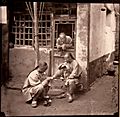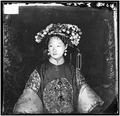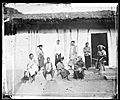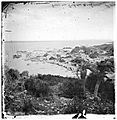John Thomson (photographer) facts for kids
Quick facts for kids
John Thomson
|
|
|---|---|

John Thomson, self-portrait with Honan soldiers, 1871.
|
|
| Born | 14 June 1837 Edinburgh, Scotland
|
| Died | 29 September 1921 (aged 84) Edinburgh, Scotland
|
| Alma mater | Heriot-Watt University |
| Occupation | Photographer, geographer, traveller |
| Organization | Royal Ethnological Society of London Royal Geographical Society |
|
Notable work
|
Foochow and the River Min |
John Thomson (born June 14, 1837 – died September 29, 1921) was a Scottish photographer, geographer, and traveler. He was a pioneer in photography. Thomson was one of the first photographers to journey to the Far East. He captured images of people, places, and ancient objects in Asian cultures.
When he returned home, his photos of London's street life became famous. This work is seen as an early example of social documentary photography. It helped create what we now call photojournalism. Later, he became a portrait photographer for important people in London. In 1881, he even received a special honor from the British Royal Family.
Contents
Early Life and Learning Photography
John Thomson was born in Edinburgh, Scotland, in 1837. He was one of nine children. After school in the 1850s, he became an apprentice. He learned to make optical and scientific tools. During this time, Thomson also learned the basics of photography. He finished his training around 1858.
He also took evening classes at the Watt Institution. This school later became Heriot-Watt University. In 1857 and 1858, he earned certificates in science and math. By 1861, he joined the Royal Scottish Society of Arts. But in 1862, he decided to travel. He went to Singapore to join his older brother, William, who was a watchmaker and photographer.
Adventures in the Far East
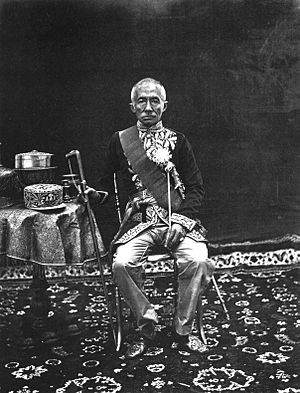
In April 1862, Thomson left Scotland for Singapore. This began ten years of travel in the Far East. First, he started a business with his brother. They made marine clocks and other instruments. He also opened a photographic studio in Singapore. He took pictures of European traders. But he also became very interested in local people and places. He traveled a lot in Malaya and Sumatra. He explored villages and photographed the local people and their daily lives.
From October to November 1864, he visited Ceylon and India. He photographed the damage from a big storm. After this, Thomson sold his studio in Singapore. He moved to Siam (now Thailand). He arrived in Bangkok in September 1865. There, Thomson took many photos of the King of Siam and other royal family members.
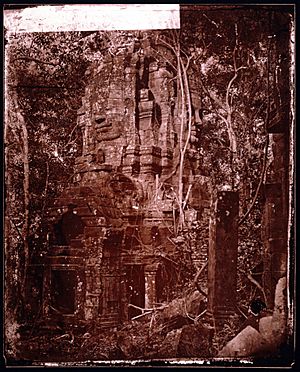
Thomson was inspired by stories of the ancient city of Angkor in Cambodia. So, he began his first major photo trip. He started in January 1866 with his translator, H. G. Kennedy. Kennedy saved Thomson's life when he got sick on the way. They spent two weeks at Angkor. Thomson took many photos of the huge site. These were some of the first pictures ever taken of this place. Today, Angkor is a UNESCO World Heritage Site.
Thomson then went to Phnom Penh. He photographed the King of Cambodia and his family. After that, he traveled to Saigon. He stayed briefly in Bangkok before returning to Britain in mid-1866. Back home, Thomson gave many talks. He also published his photos of Siam and Cambodia. He became a member of important societies, like the Royal Geographical Society. In 1867, he published his first book, The Antiquities of Cambodia.
Exploring China with a Camera
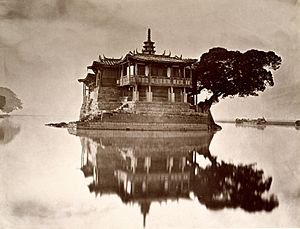
After a year in Britain, Thomson wanted to return to Asia. He went back to Singapore in July 1867. Then he spent three months in Saigon. Finally, he settled in Hong Kong in 1868. He opened a studio there. For the next four years, he photographed the people of China. He showed the many different parts of Chinese culture.
Thomson traveled widely across China. He went from the trading ports of Hong Kong and Canton in the south. He visited cities like Peking and Shanghai. He even went to the Great Wall in the north. He also explored deep into central China. From 1870 to 1871, he visited the Fukien region. He traveled up the Min River by boat. He also visited Amoy and Swatow.
He then visited the island of Formosa (modern-day Taiwan). This was in early April 1871. He landed first in Takao. He visited the capital, Taiwanfu (now Tainan). Then he traveled to the villages of the Taiwanese aborigines on the island's west plains. After leaving Formosa, Thomson spent three months traveling 3,000 miles up the Yangtze River. He reached Hupeh and Szechuan.
Thomson's trips in China were often dangerous. He visited remote areas where few people lived. Most people he met had never seen a Westerner or a camera before. His journeys were also hard because he carried heavy equipment. This included his large wooden camera, many fragile glass plates, and chemicals. He took photos in all kinds of weather. He often had to find solutions on the spot because chemicals were hard to get. His photos showed many different subjects. He photographed humble beggars and street people. He also took pictures of important officials, princes, and royal palaces. He captured simple villages and grand landscapes.
Later Life and Important Work
Thomson returned to England in 1872. He settled in Brixton, London. He never left England again, except for a trip to Cyprus in 1878. In the years that followed, he gave talks and published books. He shared the amazing results of his travels in Asia. His work first appeared in magazines. Then he published a series of large, beautifully illustrated photo books. He also wrote many articles about photography for journals. He even translated a famous photography handbook.
In London, Thomson met Adolphe Smith again. Smith was a journalist. Together, they created a monthly magazine called Street Life in London. This was from 1876 to 1877. The project used photos and words to show the lives of London's street people. This work helped establish social documentary photography. It was an early form of photojournalism. The photos were later published as a book in 1878.
Thomson became a member of the Photographic Society in 1879. His reputation as a great photographer grew. He opened a portrait studio in London in 1879. Later, he moved it to Mayfair. In 1881, Queen Victoria appointed him as a photographer to the British Royal Family. His later work focused on taking portraits of rich and famous people. This gave him a comfortable life. From 1886, he also taught explorers at the Royal Geographical Society. He showed them how to use photography to record their journeys.
Thomson retired from his studio in 1910. He spent most of his time back in Edinburgh. He continued to write papers for the Royal Geographical Society. He wrote about how photography could be used. He passed away from a heart attack in 1921 at age 84.
John Thomson's Legacy
John Thomson was a very skilled photographer. He took pictures of landscapes, portraits, street scenes, and buildings. His work is known for its high quality and wide range of subjects. His photos from the Far East taught people in Victorian Britain about the lands, people, and cultures of China and Southeast Asia.
His pioneering work on London's street life made him a founder of photojournalism. His books also showed new ways to combine photos with written stories. To honor his work, a peak on Mount Kenya was named "Point Thomson" after his death in 1921. That same year, Henry Wellcome bought over 600 of Thomson's glass negatives. Today, these are kept at the Wellcome Library. You can also see some of Thomson's work at the Royal Geographical Society in London.
An exhibit called Through the Lens of John Thomson: China and Siam is currently traveling around the world. It features some of his photos from the Wellcome Library.
Selected Works
- The Antiquities of Cambodia (1867)
- Views on the North River (1870)
- Foochow and the River Min (1873)
- Illustrations of China and Its People (1873–1874). (Four volumes)
- The Straits of Malacca, Indo-China, and China (1875)
- Street Life in London (1878)
- Through Cyprus with a Camera in the Autumn of 1878 (1879)
- Through China with a Camera (1898)
Selected Photographs
-
Carving from Angkor Wat Temple, 1866
-
China: A Manchu Bride, 1871
Images for kids
See also
 In Spanish: John Thomson (fotógrafo) para niños
In Spanish: John Thomson (fotógrafo) para niños










